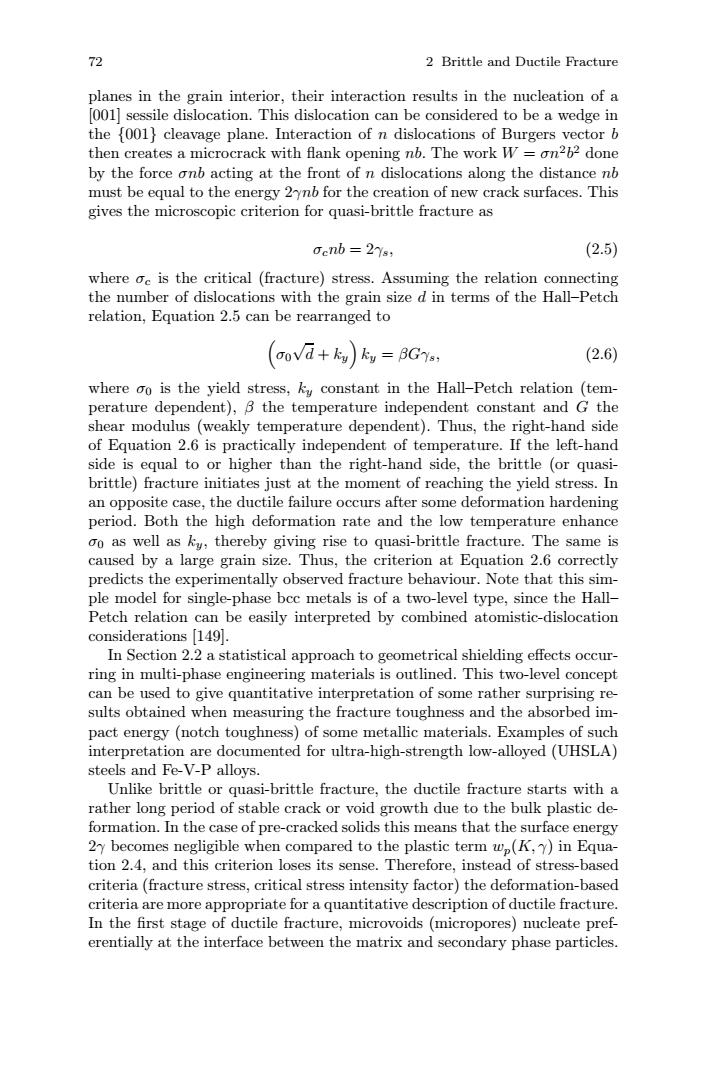正在加载图片...

72 2 Brittle and Ductile Fracture planes in the grain interior,their interaction results in the nucleation of a 001]sessile dislocation.This dislocation can be considered to be a wedge in the (001 cleavage plane.Interaction of n dislocations of Burgers vector b then creates a microcrack with flank opening nb.The work W=on262 done by the force onb acting at the front of n dislocations along the distance nb must be equal to the energy 2ynb for the creation of new crack surfaces.This gives the microscopic criterion for quasi-brittle fracture as Ocnb =2Ys; (2.5) where oc is the critical (fracture)stress.Assuming the relation connecting the number of dislocations with the grain size d in terms of the Hall-Petch relation,Equation 2.5 can be rearranged to (ova+ku ky BGT (2.6) where oo is the yield stress,ky constant in the Hall-Petch relation (tem- perature dependent),B the temperature independent constant and G the shear modulus (weakly temperature dependent).Thus,the right-hand side of Equation 2.6 is practically independent of temperature.If the left-hand side is equal to or higher than the right-hand side,the brittle (or quasi- brittle)fracture initiates just at the moment of reaching the yield stress.In an opposite case,the ductile failure occurs after some deformation hardening period.Both the high deformation rate and the low temperature enhance oo as well as ky,thereby giving rise to quasi-brittle fracture.The same is caused by a large grain size.Thus,the criterion at Equation 2.6 correctly predicts the experimentally observed fracture behaviour.Note that this sim- ple model for single-phase bcc metals is of a two-level type,since the Hall- Petch relation can be easily interpreted by combined atomistic-dislocation considerations 149. In Section 2.2 a statistical approach to geometrical shielding effects occur- ring in multi-phase engineering materials is outlined.This two-level concept can be used to give quantitative interpretation of some rather surprising re- sults obtained when measuring the fracture toughness and the absorbed im- pact energy (notch toughness)of some metallic materials.Examples of such interpretation are documented for ultra-high-strength low-alloyed(UHSLA) steels and Fe-V-P alloys. Unlike brittle or quasi-brittle fracture,the ductile fracture starts with a rather long period of stable crack or void growth due to the bulk plastic de- formation.In the case of pre-cracked solids this means that the surface energy 2y becomes negligible when compared to the plastic term wp(K,Y)in Equa- tion 2.4,and this criterion loses its sense.Therefore,instead of stress-based criteria(fracture stress,critical stress intensity factor)the deformation-based criteria are more appropriate for a quantitative description of ductile fracture. In the first stage of ductile fracture,microvoids (micropores)nucleate pref- erentially at the interface between the matrix and secondary phase particles.72 2 Brittle and Ductile Fracture planes in the grain interior, their interaction results in the nucleation of a [001] sessile dislocation. This dislocation can be considered to be a wedge in the {001} cleavage plane. Interaction of n dislocations of Burgers vector b then creates a microcrack with flank opening nb. The work W = σn2b2 done by the force σnb acting at the front of n dislocations along the distance nb must be equal to the energy 2γnb for the creation of new crack surfaces. This gives the microscopic criterion for quasi-brittle fracture as σcnb = 2γs, (2.5) where σc is the critical (fracture) stress. Assuming the relation connecting the number of dislocations with the grain size d in terms of the Hall–Petch relation, Equation 2.5 can be rearranged to σ0 √ d + ky ky = βGγs, (2.6) where σ0 is the yield stress, ky constant in the Hall–Petch relation (temperature dependent), β the temperature independent constant and G the shear modulus (weakly temperature dependent). Thus, the right-hand side of Equation 2.6 is practically independent of temperature. If the left-hand side is equal to or higher than the right-hand side, the brittle (or quasibrittle) fracture initiates just at the moment of reaching the yield stress. In an opposite case, the ductile failure occurs after some deformation hardening period. Both the high deformation rate and the low temperature enhance σ0 as well as ky, thereby giving rise to quasi-brittle fracture. The same is caused by a large grain size. Thus, the criterion at Equation 2.6 correctly predicts the experimentally observed fracture behaviour. Note that this simple model for single-phase bcc metals is of a two-level type, since the Hall– Petch relation can be easily interpreted by combined atomistic-dislocation considerations [149]. In Section 2.2 a statistical approach to geometrical shielding effects occurring in multi-phase engineering materials is outlined. This two-level concept can be used to give quantitative interpretation of some rather surprising results obtained when measuring the fracture toughness and the absorbed impact energy (notch toughness) of some metallic materials. Examples of such interpretation are documented for ultra-high-strength low-alloyed (UHSLA) steels and Fe-V-P alloys. Unlike brittle or quasi-brittle fracture, the ductile fracture starts with a rather long period of stable crack or void growth due to the bulk plastic deformation. In the case of pre-cracked solids this means that the surface energy 2γ becomes negligible when compared to the plastic term wp(K, γ) in Equation 2.4, and this criterion loses its sense. Therefore, instead of stress-based criteria (fracture stress, critical stress intensity factor) the deformation-based criteria are more appropriate for a quantitative description of ductile fracture. In the first stage of ductile fracture, microvoids (micropores) nucleate preferentially at the interface between the matrix and secondary phase particles